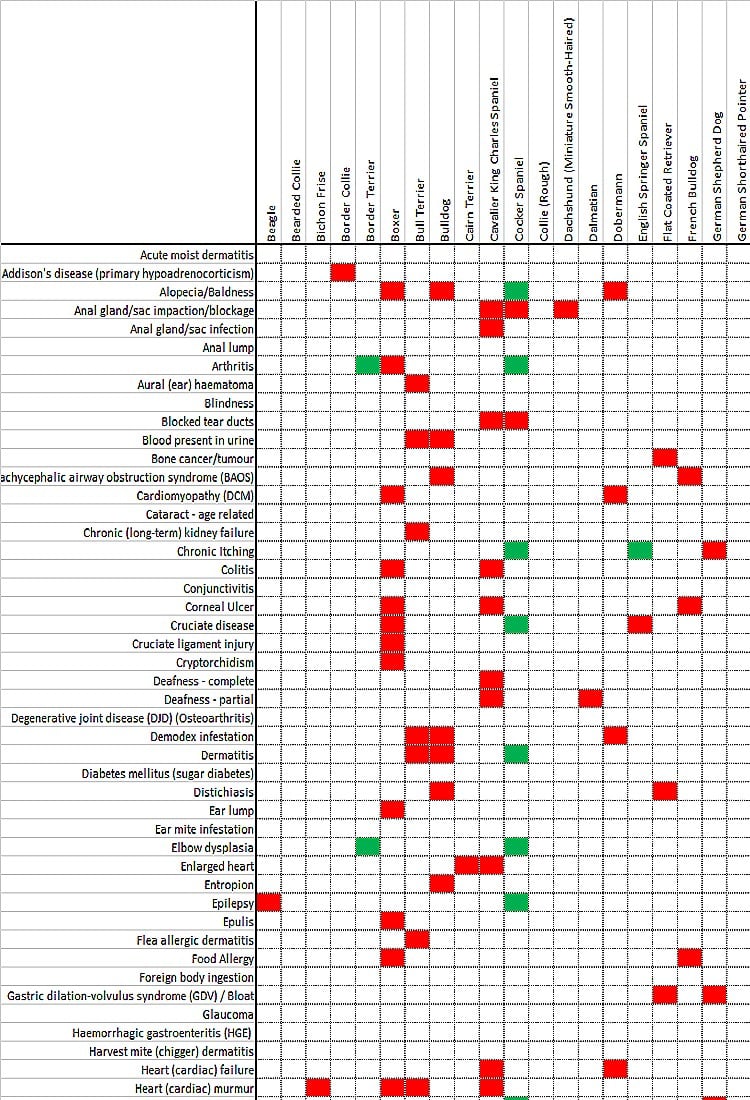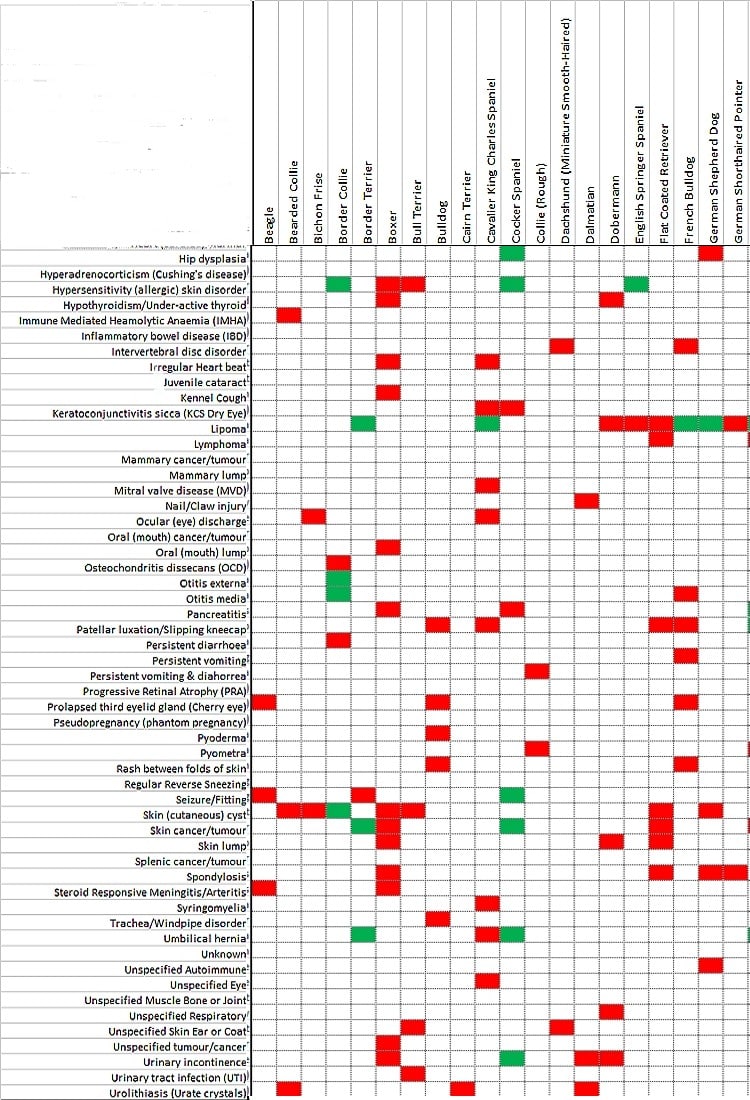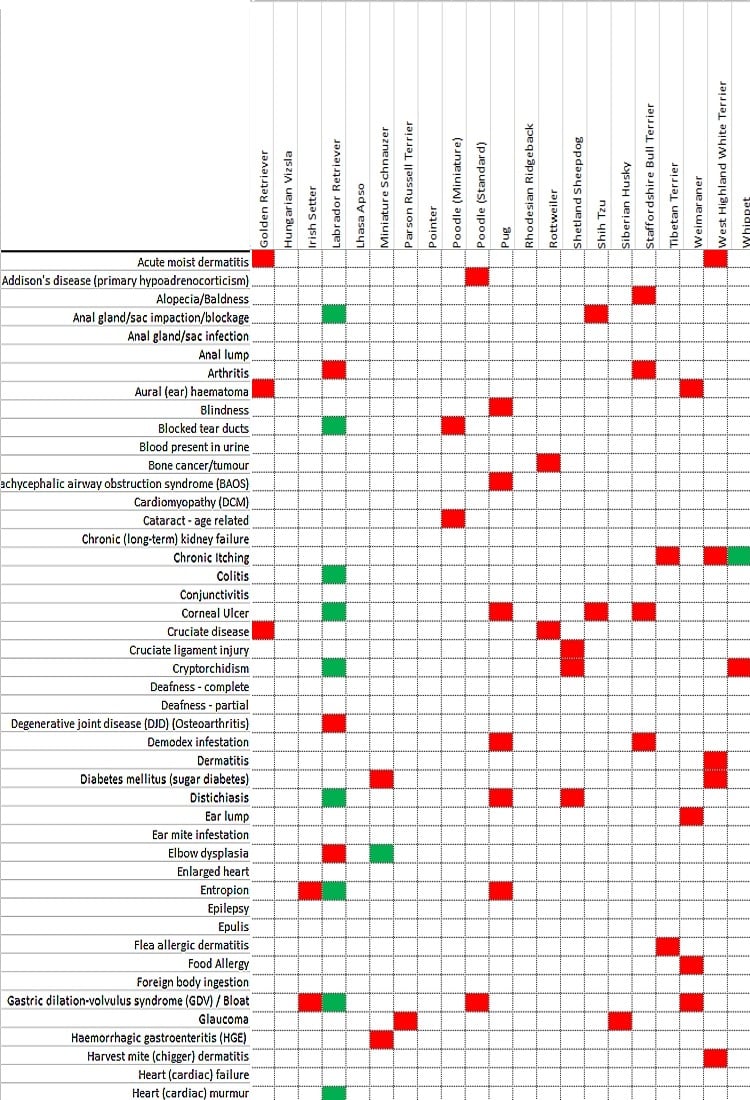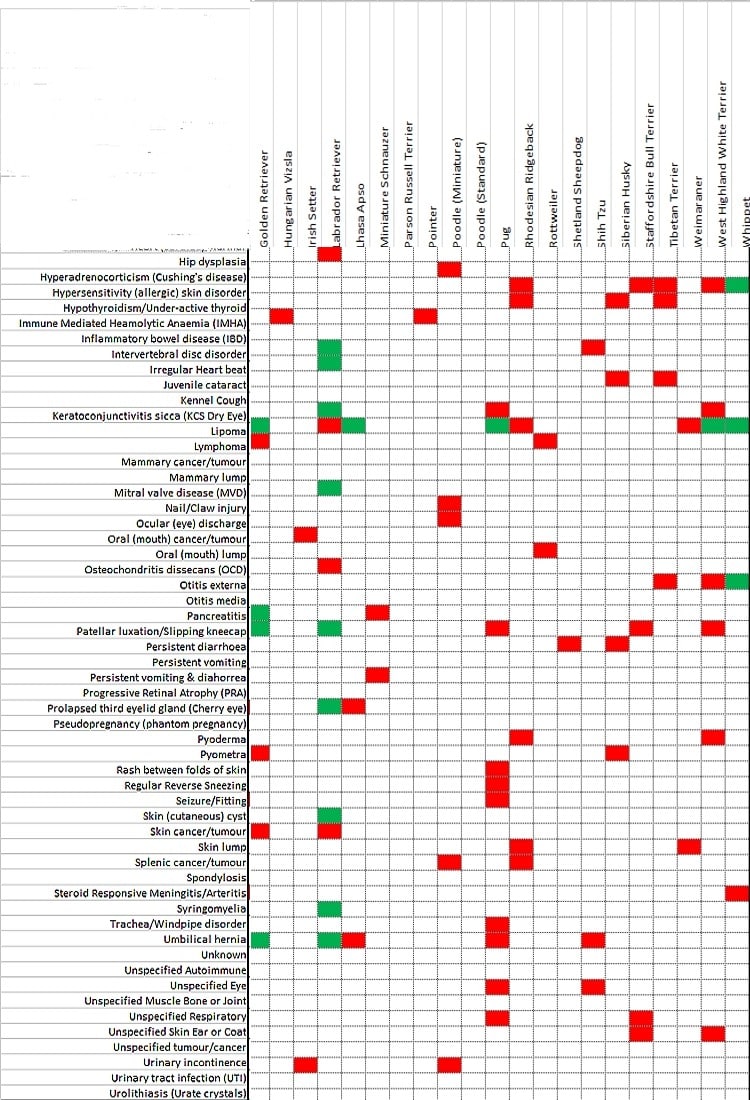No products in the cart.
Dog illnesses compared across 41 breeds & how to prevent that illness with nutrition

Stop the press and hold onto your leashes!
THIS is one of the greatest, most extensive Dog NEWS stories on dog breeds and FOOD selection you might read this year.
Seemingly a big claim, but based on the science paper based on a UK survey collected on 43,005 dogs, across 187 breeds in 2017 it’s the most extensive current information I have seen on what illnesses are likely to occur in a specific breed of dog – compared to the average breed.
We use this UK data, as Australian large-scale databases are very difficult to find. And the UK has the highest dog ownership rate in the world.
AND much more than that. What if I told you that this is exactly the kind of hard data that massive corporations use to blend micro ingredients into regular dog food pellets, to tell you it’s targeted at a specific breed, and that’s why they have to charge you a premium?
What if I told you, that now you are armed with this kind of knowledge, you could feed your dog’s your regular premium dog food, but make a very cost effective genuine big boost to your dog’s health, by feeding them macro nutrients via single ingredient Meat dog treats.
The Dog breed illness methodology
Typically, in statistics scientists like over 32 dogs in any segment of a population to have a good ‘confidence interval’ on the results – that the results will be meaningful and reproducible.
This is how many UK Kennel club members responded.
- 43,005 unique live dogs,
- Survey data was spread across 187 breeds
- 88% were male (n = 21,882) and 53.53% were neutered (n = 23,021). The median age of dogs at the time of survey was 4.47 years
Nine breeds in the survey actually had OVER 1000 unique dogs in their segment. These were (Labrador Retriever, Cocker Spaniel, English Springer Spaniel, Golden Retriever, Border Terrier, German Shepherd Dog, Cavalier King Charles Spaniel, Miniature Schnauzer, and Border Collie.
The only caveat on this survey is that in the interest of robustness, the authors decided to make the cut off for inclusion of a breed in the results (in graph form) only if it had over 200 dogs in its breed segment.
There are full data sheets available showing the results for each breed (regardless of sample size) – and if there were over 50 or so of that breed, many people would still consider the results for that breed still quite relevant.
They say: “Ninety of the 101 (89.1%) common disorders showed a significant difference between the within breed and the overall prevalence for at least one of the 41 breeds. There was no significant difference shown in 11 diseases/conditions (anal lump, conjunctivitis, ear mite infestation, foreign body ingestion, inflammatory bowel disease, mammary cancer/tumour, mammary lump, progressive retinal atrophy, pseudopregnancy [phantom pregnancy], unknown, unspecified Muscle Bone or Joint).” ref 1
“ The disease/condition showing the greatest number of significant differences between within breed prevalence and the overall prevalence estimate was lipoma (seven breeds with a significantly higher prevalence, and nine breeds with a significantly lower prevalence).
If you are wondering – “lipoma is a very common benign mass made up exclusively of fat cells. While the vast majority of lipomas are located just under the skin anywhere in the body, these lumpy masses may also develop in the abdomen and chest.” They tend to affect older dogs, and we have had surgery on our dog Archie to remove a few of them, when they grew too large and were affecting his gate or likely to get knocked and potentially rupture.
But for the sake of this article, we review the Graph results for the diseases surveyed, only 41 breeds are graphically represented below.

Very simply, 41 breeds (with over 200 sample dogs in them) are listed on the horizontal axis.
If that breed has a significantly (P < 0.05) higher likelihood of disease than the average breed dog it has a RED square in its column. A green SQUARE MEANS lower breed prevalence per disease/condition than the overall prevalence determined from all responses (n = 43,005).
Each breed will be shown on two images (to fit in the 110 main diseases that were found int the survey) and to make it more legible.
Ninety of the 101 (89.1%) common disorders showed a significant difference between the within breed and the overall prevalence for at least one of the 41 breeds. So the 41 dog breeds are shown against 90 of the common diseases in the graph below.
So that the article isn’t all graphs, we show the second half of the breeds in the appendix graphs.

HOW TO use the dog illness graph
There are many potential uses for this kind of data and graphical representation.
As a dog owner, you might be interested in knowing what kind of illness are most common to the breed of dog you have. If you have a designer dog, or a mixed breed dog you know some of the breeds in from DNA testing, you might consider the illnesses of the contributing breeds.
Not only might you be able to prevent an issue using physical therapy or looking for common signs of the common illness that a breed tends to get.
NOTE this project highlights if a dog breed is exceptionally worse or better than the average dog at having a specific disease. If a dog was average compared to all the other breeds, there would be NO coloured square in its column.
In the next blog we look at the most popular dogs in Australia and what their main illnesses are likely to be.
Examples.
It is amazing to see on the first graph that the BEAGLE only scores worse than the average dog for epilepsy, and the German Short haired pointer DOESN’T rate worse on ANY of the first half of the common dog illnesses.
The second Set of illnesses shows that the beagle only has THREE RED squares next to illnesses. It is likely that this breeds general health is part of the reason that so many beagles are used in scientific studies and dog food trials.
Compare this to dog breeds like the boxer that have MANY red squares next to illnesses. And in fact MANY of these illnesses are life threatening illnesses. This should alert owners to the importance of getting a very good breeder, running many tests before accepting a pup, and that they will probably need a very good private health insurance and know of the likely diseases so they can watch for the signs of illnesses.
On the flip side – and a GOOD news story for my dog Archie who is HALF cocker spaniel, the Cocker seems to have one of the largest batch of GREEN squares next to potential diseases, suggesting, at least from this data set, that the cocker breed in general, compared to the average dog breed, might have above average healthy outcomes (and lower susceptibility to the common 90 illnesses shown in the matrix.
Other specific dog breed illness conditions
While this survey was extensive, it only showed breeds in comparison to each other, and gave a red or green mark, IF a breed was much higher or lower than the average breed to have that illness. It doesn’t indicate what specific illnesses any breed might be pre disposed to having.
I would recommend looking up AKC breed specific information for that. If you can find an equivalent reliable Australian resource that is of course fine too. I have suggested the American kennel club since they have a lot of power in deciding characteristics that breeds should have, and America has many more dogs to compile the database from.
For example, the Labrador retriever AKC HEALTH concerns tab gives the following information.
“Labs are healthy dogs overall, BUT they can suffer from:
- elbow and hip dysplasia,
- heart disorders,
- hereditary myopathy (muscle weakness), and eye conditions, including progressive retinal atrophy.
- exercise induced collapse (EIC) can occur in some young adult Labs;
They then give the standard advice that all prospective owners should heed:
a DNA test allows breeders to identify carriers of any hereditary disease. And x-rays etc can check the stability of dog’s bones that are subject to joint issues.
HOW TO supplement dog food based on Dog illness likelihoods

One of the non-life threatening, but severely limiting quality of life diseases that ageing dogs (and even some breeds very early on get, is arthritis and joint pain issues. Bone angles, growth rates, cartilage formation or even the viscosity of the liquid between the joints can affect inflammation and cause chronic diseases.
We know that shark cartilage and green lipped mussels with their high chondroitin and glucosamine levels have a major benefit for many dogs suffering joint and cartilage issues.
From the matrix, these are the dog breeds deemed to have higher levels of joint illnesses:
- Arthritis breeds: boxer, Labrador, Staffordshire bull terrier
- Cruciate Disease: boxer, English Springer Spaniel, golden retriever, Rottweiler.
- Cruciate Ligament injury: boxer, Shetland sheepdog
- Degenerative Joint disease (DJD): Labrador retriever.
- Elbow dysplasia: Labrador retriever.
- Hip Dysplasia: German Shepherd, Labrador retriever.
While arthritis is common in older dogs, middle aged dogs have been known to rupture their CCL. The cranial cruciate ligament (CCL) (known as the anterior cruciate ligament, or ACL, in humans) is one of several ligaments in the stifle (knee) that connect the femur (thigh bone) to the tibia (shin bone).
We have been unable to find the total proportion of dogs who do their CCL, but we know that tears are the MOST COMMON orthopedic injury in dogs. And it’s estimated that around 40% of dogs who tear one ACL will tear the other ACL within a few years.
Most dogs are active and while the rear legs are the ones that mostly get CCL injuries, front leg elbows arthritis is also very common. Prevention of arthritis makes much more sense than treatment and joint support dog treats is one way of achieving that.
CONCLUSIONS
Most vets we have talked to simply discuss putting a dog on a “good” vet recommended kibble.
But we now ALSO sell a very good dry dog food kibble. (Check out the Healthy DOG FOOD category on this site).
They rarely mention regular off lead walks (to build social skills and muscle tissue) – OR raw feeding OR the benefit of Meat or joint support treats like shark cartilage or Green lipped mussels.
Most things we sell, you can purchase one way or another, refined, and costing much more via vets or specialty stores. But you won’t be getting WHOLE foods, with the full array of support natural chemicals.
The reality is that this blog analysis, while extensive and based on 40,000 dogs, kept the threshold very high at 200 dogs for a sample breed before it would display data on the graphs. The survey was also of owners, not vet records, and the nature of care or food of the dogs is unknown.
Also, that AGE of each breed varied significantly, with a younger average age of dogs from a respondent group, unlikely to have suffered and extensive array of illnesses that a mature dog might encounter.
BUT if your breed is represented there, AND there is a colour square – it means that it is very significantly better or worse for that illness than the average dog. Something to heed in its food supplements or exercise type etc.
In the realm of healthy dog treats, we know that many of our single ingredient treats, can very effectively support joint maintenance programs (ie before issues occur), many are ORGANIC (do don’t have chemicals associated with intensive farming in the meat).
Many have natural forms of Omega 3 (helping brain, skin and coat maintenance).
Single ingredient meat dog treats are very bio-available, so any dog (that is not allergic to meat) can make the most of digesting the proteins in the meat. And single ingredient Meat jerky is up to THREE times the proportion of meat that you will find in most commercial dog food.
We always put the dog first, and knowing what kinds of illness your breed (or breeds of dog in a mixed breed case) are susceptible to, might assist you in using preventative food supplements before a major issue occurs.
Reference
Large-scale survey to estimate the prevalence of disorders for 192 Kennel Club registered breeds, UK Kennel Club, 2014, PUB Canine Genetics and Epidemiology volume 4,
APPENDIX
Dog illness matrix, beginning with Golden Retriever breed.

Dog Illness – Part two



